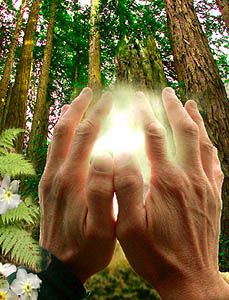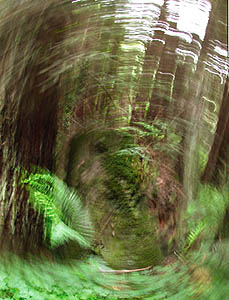![[Metroactive News&Issues]](/gifs/news468.gif)
[ Santa Cruz Week | SantaCruz Home | Archives ]
Fairy Tales
In a post-'X-Files' world, fairies may be the next big--er, little--thing. Here in Santa Cruz, they even have a spokesperson ...
By Rebecca Patt
YOU BELIEVE IN fairies, right? It's OK, you can admit it. This is Santa Cruz. But wait, I'm not just talking about the fairies who wear lipstick and strut around the Dakota. I'm talking about ... well, Tinker Bell. Except for real. Supposedly.
Around here, testimonials of fairy sightings abound, and boy, do they come out of the woodwork when you're working on a story like this. Fairies are said to be of all shapes and sizes and in all different locations. One local said he glimpsed some wee folk fluttering around a field of wildflowers in Utah. Another said he's seen the Mothman, a Shaquille O'Neal-sized, brown-winged creature, while at a rest stop in Humboldt. Yet another claimed to have encountered one of the legendary Menehune--the swarthy, fierce little people of Hawaiian mythology--while on a camping trip in Kauai.
But if fairies exist, you know we're going to get stuck with them in Santa Cruz. We were practically asking for it with that whole Elfland thing. And indeed, if you had to pick a ground zero for the emerging fairy phenomenon--which from the looks of it may very well snowball into something like the angel craze a decade ago--this just might be the place.
Santa Cruz even has a sort of de facto spokesperson for fairies, in the form of Bonny Doon resident Nicola Amadora, Ph.D. Amadora is a petite blonde with blue eyes and a German accent, and she looks a bit like Tinker Bell herself. The first thing you notice about her is that she doesn't seem at all delusional. She comes across as a totally grounded, big-hearted person who radiates the same qualities of strength and gentleness that she attributes to fairies.
The Great Fairy Hoax: Got any fairy photos you want to sell us?
Folk Movement
Amadora says she became interested in communication with fairies when she was a teenager, and eventually began seeking out the wee ones not just in this country but all around the world, from South America to the Himalayas. She also spent seven years at Findhorn, the famous intentional community in Scotland, where amazing gardening feats like growing huge cabbages in the sand are attributed to assistance from the higher intelligence of the fairy realm. Scotland, England, and Ireland especially are hot spots for fairy activity, says Amadora, because of the Celtic tradition that is filled with lore about fairies.
Clearly, this is a not a woman who has any doubts about what's she's doing, nor does she care if some people think she's nuts for believing she can communicate with fairy folk. Though she claims she had long felt their existence was "a reality that became so apparent to me every time I was in nature," there eventually came--as there must in every fairy tale worth telling--a point of contact.
"In the beginning I heard them speaking in a voice," she says. "Then it became a sensation, a feeling, an image, all of me." As you've probably noticed by now, this fairy communication business is heady stuff.
Amadora says the fairies have recently called upon her to spread the word about them, so she has been giving lectures about nature communication and also gives workshops from her garden--and considering her busy schedule, which also includes her duties as mother, psychologist and leader of a retreat center she and her husband run out of their home, it's amazing she has time to talk to anyone, let alone mysterious wood folk.
But talk she has, and her fairy information has been in high demand. She drew an overflow crowd to her workshop on fairies at this year's Ecological Farming Conference (the country's largest annual powwow of organic farmers, held every February in Pacific Grove), and a recent appearance on KUSP led to invitations from 15 other radio stations.
Amadora is not the only one drawing an audience with her insight into the fairy world. In 2001, the first annual Fairy and Human Relations Congress was held in Washington, where a few hundred humans were reportedly joined by untold numbers of fairies and nature spirits for communication and edification. And several authors with an ideology similar to Amadora's have written popular books on the subject--an especially grabbing read is The Elves of Lily Hill Farm by Penny Kelly, the story of her alleged relationship with the resident elves at her vineyard in Michigan. Another author, Machaelle Small Wright, has built a small empire of books, videos and products based around her work with nature spirits at her Virginia farm called Perelandra.
The Fairy Backlash
While a few people are building a life's work out of promoting the existence of fairies, there are plenty of skeptics, as well. James Randi, a.k.a. The Amazing Randi, has built a reputation as one of the world's pre-eminent investigators of the supernatural, debunking just these sorts of claims, and his book Flim-Flam! includes the definitive exposé of the Cottingley fairy hoax that occurred in England in the 1920s (see sidebar). Randi, who is also a magician and escape artist, spoke to Metro Santa Cruz from his office in Florida, where he apparently hangs out by the phone like one of the Ghostbusters.
And as for Amadora's story, he's having none of it. "There is no evidence for fairies, only anecdotal stories," says Randi. "If there's evidence, then she could win our million-dollar prize."
The James Randi Educational Foundation offers a million-dollar prize to anyone who can prove the existence of supernatural phenomena. He says that if any of the claims were true, he would have given away the prize long ago.
Randi is known for a somewhat gruff persona when it comes to this kind of thing, and he says that until there some hard evidence, he doesn't care what anyone believes they see.
"I may believe that I am Richard Nixon if I am nutty enough," he says, "but belief has nothing to do with reality."
Living Fairy-Friendly
Amadora says she recognizes that some people think her experiences are all "airy-fairy made-up stuff." They think she's kooky, but she thinks they're out of touch with nature. Other people, she says, want to know how they can communicate with fairies themselves.
Turns out if you believe in fairies, you've gotta do a lot more than clap your hands.
First, there's the question of what fairies supposedly are in the first place. According to Amadora, fairies are a human projection of the "devic" realm. Deva (pronounced dee-vuh) is a Sanskrit term for "shining ones" and refers to the "presence of energy that holds the highest potential of what is possible," according to Amadora. She says fairies tend to manifest themselves according to whatever people hold as an image of them. For example, she says that fairies in Costa Rica tend to be hairy creatures, while fairies in England are more likely to show up wearing suspenders and smoking a pipe.
Beyond that, there's the issue of why it might be useful to communicate with fairies, beyond the obvious advantages in a power outage. Amadora certainly makes it sound pretty bitchen, that's for sure.
"There is an enormous well of wisdom to tap into," she says, "a knowledge and wisdom that we don't necessarily have by ourselves."
Then, of course, there's how. One might start, it appears, in the garden. Amadora's is full of little altars celebrating a range of religious traditions. There's a section for vegetables, lots of wildflowers, plants that attract butterflies, and many fruit trees. Beside the meditation hut is an avocado tree--quite a phenomenon itself in frosty Bonny Doon--that Amadora has lovingly nurtured.
Occupying a significant portion of one corner of her garden is a "Wild Area," marked with a sign and designated especially for the fairies and for anything wild, where no human beings are supposed to go or to touch anything.
"I teach people to designate an area for nature to do what nature needs to do. The fairies told me that clearly," she says. "Create a little area, make a home for them. Dedicate even a tiny corner, and let them know you are willing to work with them."
When Amadora moved in a few years back, the yard was all Scotch broom and brambles. She says she asked the devas what they wanted to happen there and got a vision in a dream of doves landing in a heart shape. Now one of the focal points of the garden is a large heart outlined in stone and filled with yellow and orange calendula flowers and strawberries. Around the heart are altars for the four elements. Nearby, a stone labyrinth is interspersed with lavender shrubs. Amadora says that in addition to feeling a sense of healing and calm as they walk though the spiral, people have a tendency to start giggling, a sensation she attributes to the presence of fairies.
They have a "a real sweetness about them," says Amadora, "usually a real sweetness that people are touched by, a lot of laughter, joy and lightness."
But they can also be fussy, apparently. She says one time they turned their backs and wouldn't talk to her for a week because they didn't like how she was yanking Scotch broom out of the ground.
"Even the Scotch broom is sacred and must be pulled out in a kind way," she says.
Tips From the Tepee
Ken Foster, proprietor of Terra Nova Landscaping, lent a hand with the irrigation in Amadora's garden--Foster is easily recognizable as the lanky, bearded guy riding around town on a lowrider bicycle with a trailer full of landscaping tools. He says he also communicates with nature spirits, although he has never seen them.
Foster's also made a funky garden sanctuary of his own on the West Side, and he's the kind of guy who offers to conduct his interview in the tepee out back. His green thumb is so prolific that plants are even growing inside the tepee. His yard is a maze of herbs and vegetables, and in place of the traditional picket fence he has a living fence made of several varieties of apple trees grafted together.
"For me it's more of a feeling, an intuition, in communicating with nature and working with plants. It's not that I see a little sprite or deva, more that I can kinda intuit something from them," he says. "The whole thing of communicating with nature is willingness to do so and willingness to hear responses back."
Amadora says that in learning to communicate with fairies one must avoid putting poisons on the ground and cultivate a spirit of cooperation with nature instead of domination. One must also learn to become still, really develop an ability to listen, and come to the task with love and pure intention. Without that, she says, "they won't talk to you. It just won't happen."
With it, you're apparently on your way. And hey, even if you don't believe in fairies, you'll probably attract a few new friends.
Amadora also confirms that Santa Cruz is a hotbed of fairy activity.
"Fairies and devas are doing well around Santa Cruz because people care about them a lot," she say. "They love nature and are open to things that are not necessarily visible to the eye."
Oh, great. Nobody tell the mothmen.
Copyright © Metro Publishing Inc. Maintained by Boulevards New Media.
![]()

Photograph by Stephen Laufer
![[line]](/gifs/line.gif)
![[line]](/gifs/line.gif)

Photograph by Stephen Laufer
From the June 5-12, 2002 issue of Metro Santa Cruz.